Involvement of the Northeastern Margin of South China Block in Rodinia Supercontinent Evolution: A Case Study of Neoproterozoic Granitic Gneiss in Rizhao Area, Shandong Province
Abstract
:1. Introduction
2. Geological Setting and Petrographic Characteristics
3. Sampling and Analytical Methods
3.1. Whole-Rock Major- and Trace- Element Analyses
3.2. Zircon U–Pb, Trace Element, and Lu–Hf Isotopic Analyses
4. Results
4.1. Whole-Rock Major- and Trace-Element Concentrations
4.2. Zircon U–Pb Ages and Trace Element Contents
4.3. Zircon Lu-Hf Isotopes
5. Discussion
5.1. Genetic Discrimination of Zircon
5.2. Diagenetic Age and Characteristics of the Magma Source
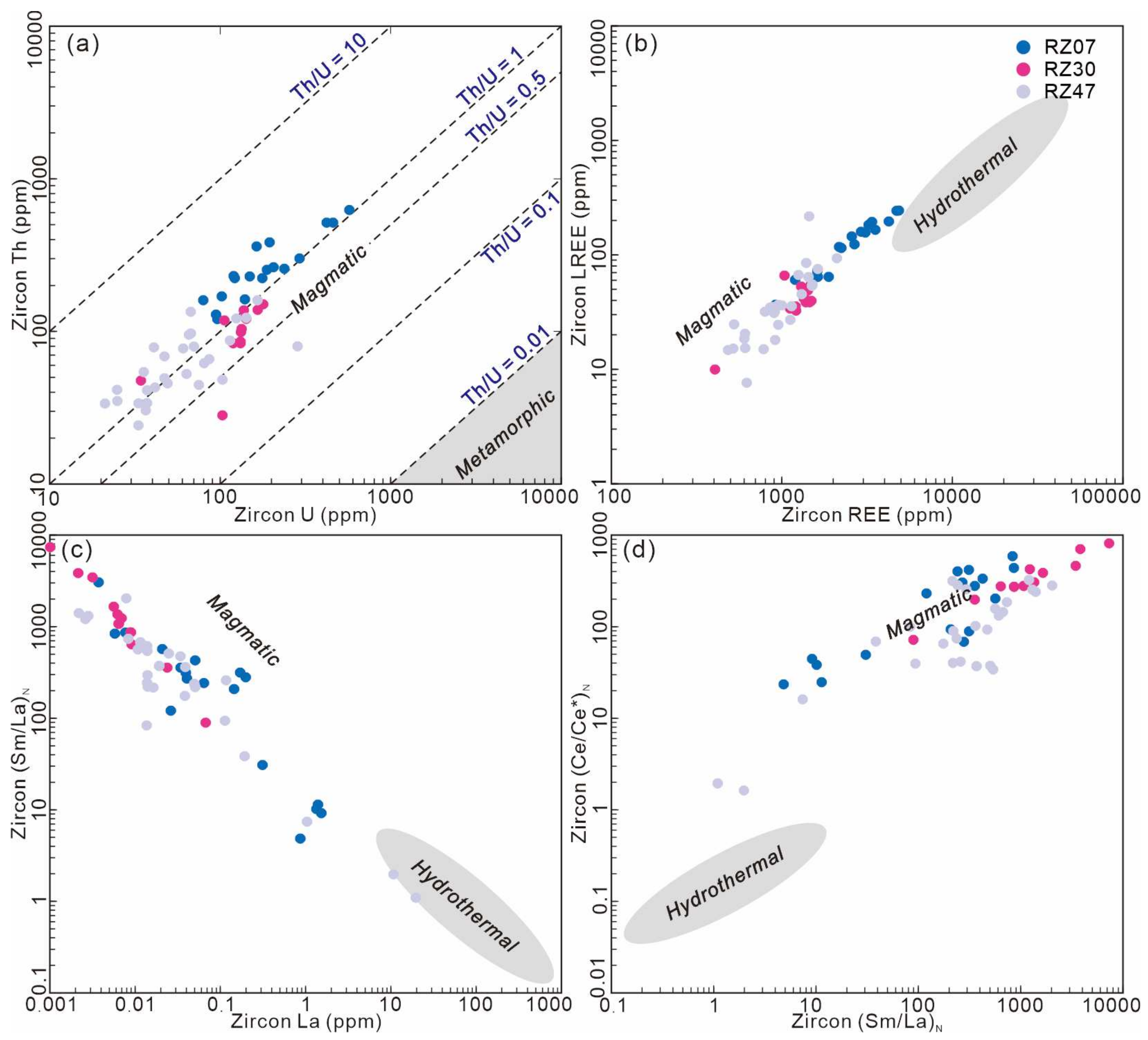
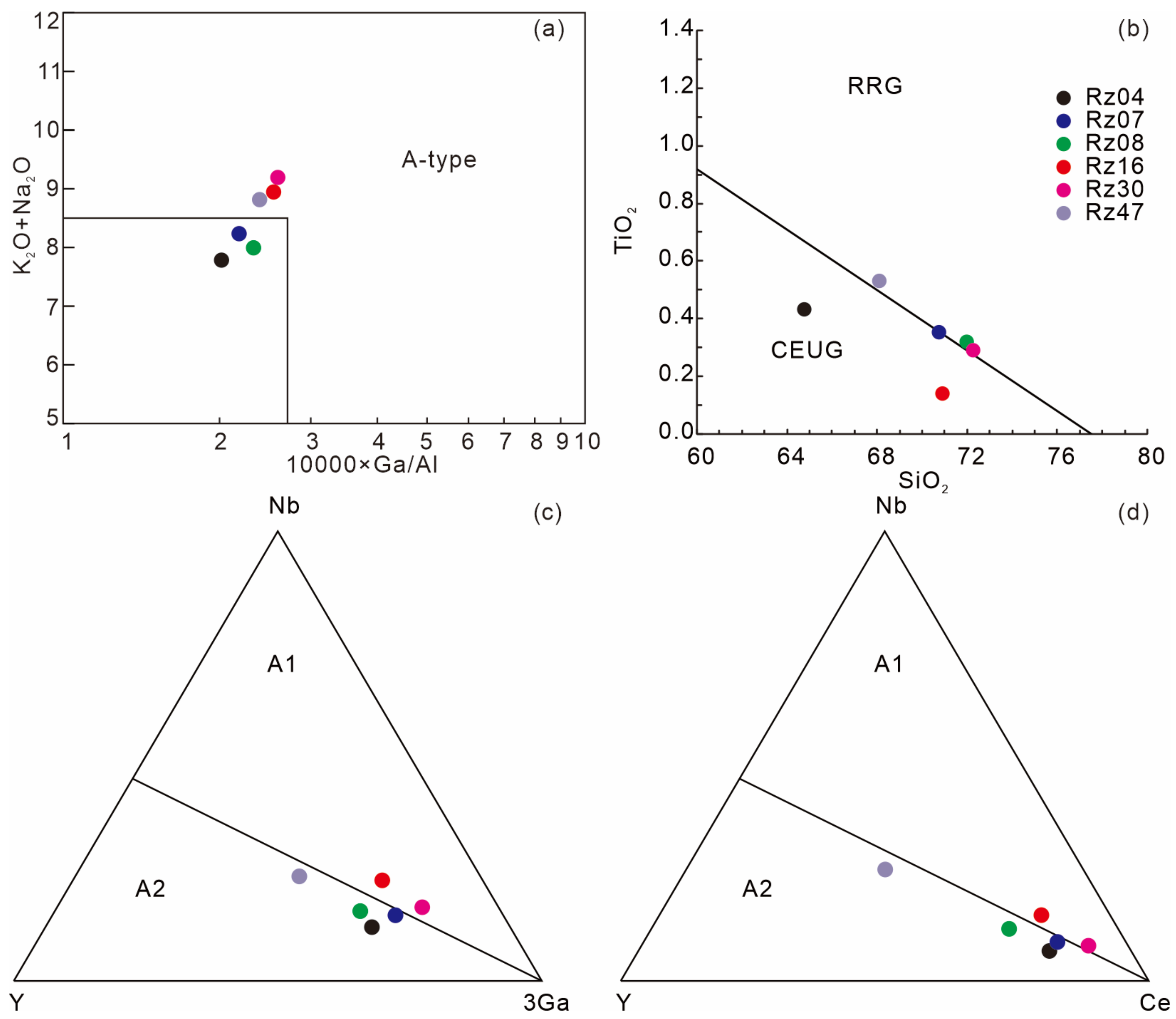
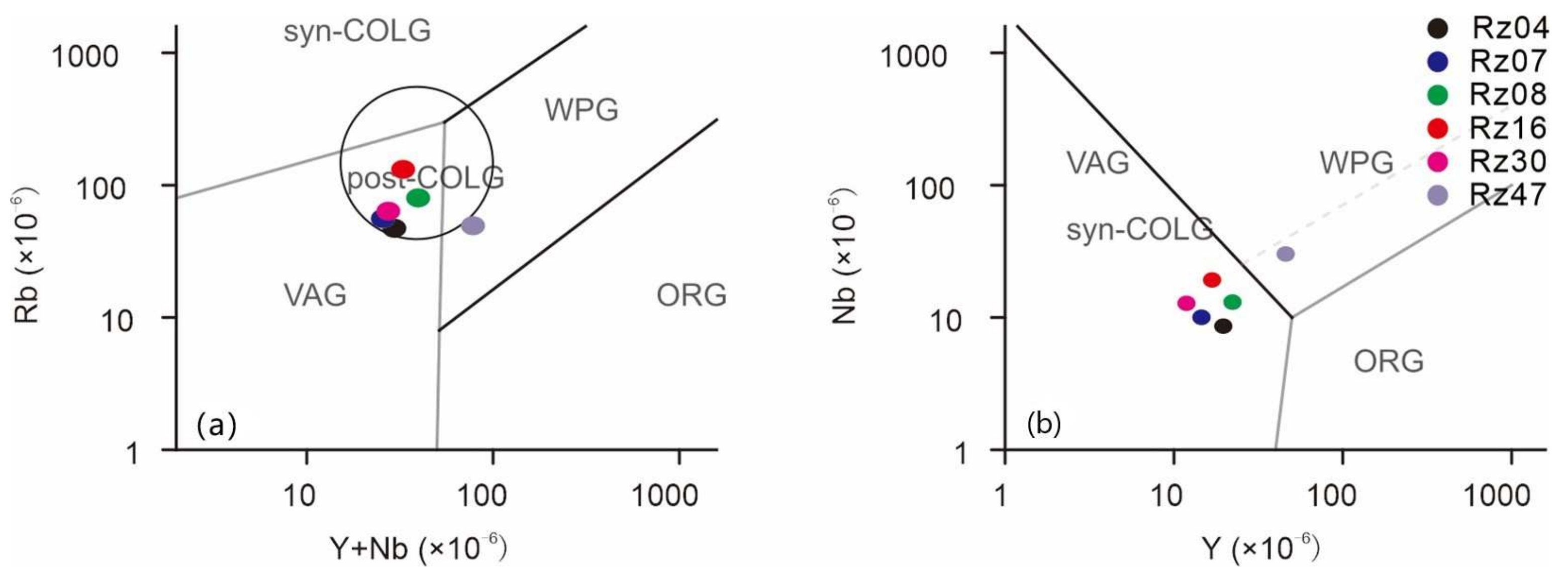
5.3. Tectonic Settings
- (1)
- Island arc-related model:
- (2)
- Mantle plume model:
- (3)
- Plate rift model:
6. Conclusions
- (1)
- The Neoproterozoic granitic gneisses in the Rizhao area formed at ~790 Ma. They are sub-alkaline series rocks with high potassium characteristics. They are also enriched in light rare earth elements, moderately depleted in heavy rare earth elements, and exhibit moderate fractionation between the two. Additionally, they display weak to moderate negative Eu anomalies and weak negative Ce anomalies. They belong to A-type granites. The mineral assemblage in the magma source area was amphibole + plagioclase.
- (2)
- Zircons from the Rizhao granitic gneisses present clear oscillatory zoning, large amorphous melt inclusions, a relatively high zircon saturation temperature, relatively high Th/U ratios, and negative εHf(t) values. The two-stage model ages (TDMC) suggest that the partial melting of a mixture of Archean crustal materials and a small amount of Paleoproterozoic juvenile continental crust components formed the granite.
- (3)
- The Rizhao granitic gneisses formed in an intraplate rifting environment on the Rodinia supercontinent.
Supplementary Materials
Author Contributions
Funding
Data Availability Statement
Acknowledgments
Conflicts of Interest
References
- McMenamin, M.A.S.; Mcmenamin, D.L.S. The Emergence of Animals: The Cambrian Breakthrough; Columbia University Press: New York, NY, USA, 1990; pp. 1–12. [Google Scholar]
- Hoffman, P.F. Did the breakup of Laurentia turn Gondwana inside out? Science 1991, 25, 1409–1412. [Google Scholar] [CrossRef] [PubMed]
- Fanning, C.M.; Daly, S.J.; Bennett, V.B.; Menot, R.P.; Monnier, O. The Mawson continent: Archean to Proterozoic crust in the East Antarctic Shield and Gawler Craton, Australia. A cornerstone in Rodinia and Gondwanalan. In Abstracts—Geological Society of Australia; Geological Society of Australia: Sydney, NSW, Australia, 1996; Volume 41, p. 135. [Google Scholar]
- Powell, C.M.; Li, Z.X.; McElhinny, M.W.; Meert, J.G.; Park, J.K. Paleomagnetic constraints on the timing of the Neoproterozoic breakup of Rodinia and the Cambrian formation of Gondwana. Geology 1993, 21, 889–892. [Google Scholar] [CrossRef]
- Li, Z.X.; Zhang, L.H.; Powell, C.M. South China in Rodinia: Part of the missing link between Australia-East Antarctic and Laurentia? Geology 1995, 23, 407–410. [Google Scholar] [CrossRef]
- Li, Z.X.; Zhang, L.H.; Powell, C.M. Positions of the East Asian cratons in the Neoproterozoic super-continent Rodinia. Aust. J. Earth Sci. 1996, 43, 593–604. [Google Scholar] [CrossRef]
- Li, Z.X.; Bogdanova, S.V.; Collins, A.S.; Davidson, A.; Waele, B.D.; Ernst, R.E.; Fitzsimons, I.C.W.; Fuck, R.A.; Gladkochub, D.P.; Jacobs, J.; et al. Assembly, configuration, and break-up history of Rodinia: Asynthesis. Precambrian Res. 2008, 160, 179–210. [Google Scholar] [CrossRef]
- Li, Z.X.; Li, X.H.; Kinny, P.D.; Wang, J.; Zhang, S.; Zhou, H. Geochronology of Neoproterozoic syn-rift magmatism in the Yangtze Craton, South China and correlations with other continents: Evidence for a mantle superplume that broke up Rodinia. Precambrian Res. 2003, 122, 85–109. [Google Scholar] [CrossRef]
- Li, Z.X.; Li, X.H.; Kinny, P.D.; Wang, J. The breakup of Rodinia: Did it start with a mantle plume beneath South China? Earth Planet. Sci. Lett. 1999, 173, 171–181. [Google Scholar] [CrossRef]
- Zheng, Y.F. The location of South China in the Neoproterozoic supercontinent configuration. Chin. Sci. Bull. 2004, 49, 715–717, (In Chinese with English Abstract). [Google Scholar]
- Zhou, M.F.; Yan, D.P.; Wang, C.L.; Qi, L.; Kennedy, A. Subduction-related origin of the 750Ma Xuelongbao adakitic complex (Sichuan Province, China): Implications for the tectonic setting of the giant Neoproterozoic magmatic event in South China. Earth Planet. Sci. Lett. 2006, 248, 286–300. [Google Scholar] [CrossRef]
- Li, Z.X.; Li, X.H.; Zhou, H.W.; Kinny, P.D. Grenvillian continental collision in south China: New SHRIMP U-Pb zircon results and implications for the configuration of Rodinia. Geology 2002, 30, 163–166. [Google Scholar] [CrossRef]
- Zhou, M.F.; Kennedy, A.K.; Sun, M.; Maipas, J.; Lesher, M.C. Neoproterozoic arc-related mafic intrusions along the northern margin of South China: Implications for the accretion of Rodinia. J. Geol. 2002, 110, 611–618. [Google Scholar] [CrossRef]
- Zheng, Y.F.; Zhang, S.B.; Zhao, Z.F.; Wu, Y.B.; Li, X.H.; Li, Z.X.; Wu, F.Y. Contrasting zircon Hf and O isotopes in the two episodes of Neoproterozoic granitoids in South China: Implications for growth and reworking of continental crust. Lithos 2007, 96, 127–150. [Google Scholar] [CrossRef]
- Zhao, G.C.; Cawood, P. Precambrian geology of China. Precambrian Res. 2012, 222, 13–54. [Google Scholar] [CrossRef]
- Li, Y. Neoproterozoic Magmatic Events in the Emeishan Region of the Western Margin of the Yangtze Block and Their Implications for the Breakup of the Rodinia Supercontinent. Master’s Thesis, Chengdu University of Technology, Chengdu, China, 2020. (In Chinese with English Abstract). [Google Scholar]
- Sláma, J.; Košler, J.; Condon, D.J.; Crowley, J.L.; Gerdes, A.; Hanchar, J.M.; Horstwood, M.S.A.; Morris, G.A.; Nasdala, L.; Norberg, N.; et al. Plešovice zircon-A new natural reference material for U-Pb and Hf isotopic microanalysis. Chem. Geol. 2008, 249, 1–35. [Google Scholar] [CrossRef]
- Hou, K.J.; Li, Y.H.; Tian, Y.R. LA-MC-ICP-MS zircon micro-area in situ U-Pb dating technique. Miner. Depos. 2002, 28, 481–492, (In Chinese with English Abstract). [Google Scholar]
- Andersen, T. Correction of common lead in U-Pb analyses that do not report 204 Pb. Chem. Geol. 2002, 192, 59–79. [Google Scholar] [CrossRef]
- Griffin, W.L.; Pearson, N.J.; Belousova, E.; Jackson, S.E.; Achterbergh, V.E.; O’Reilly, S.Y.; Shee, S.R. The Hf isotope composition of cratonic mantle: LA-MC-ICP MS analysis of zircon megacrysts in kimberlites. Geochim. Cosmochim. Acta 2000, 64, 133–147. [Google Scholar] [CrossRef]
- Griffin, W.L.; Wang, X.; Jackson, S.E.; Pearson, N.J.; O’Reilly, S.Y.; Xu, X.S.; Zhou, X.M. Zircon geochemistry and magma mixing, SE China: Insita analysis of Hf isotopes, Tonglu and Pingtan igneous complexes. Lithos 2002, 61, 237–269. [Google Scholar] [CrossRef]
- Middlemost, E.A.K. Naming materials in the magma/igneous rock system. Earth Sci. Rev. 1994, 37, 215–224. [Google Scholar] [CrossRef]
- Middlemost, E.A.K. Magmas and Magmatic Rocks; Longman: London, UK, 1985; pp. 1–266. [Google Scholar]
- Sun, S.S.; Mcdonough, W.F. Chemical and Isotopic Systematics of Ocean Basalts: Implications for Mantle Composition and Processes; Geological Society of London and Blackwell Scientific Publications: London, UK, 1989; pp. 313–345. [Google Scholar]
- Rubatto, D.; Gebauer, D. Use of cathodoluminescence for U-Pb zircon dating by IOM Microprobe: Some examples from the western Alps. In Cathodoluminescence in Geoscience; Springer: Berlin/Heidelberg, Germany, 2000; pp. 373–400. [Google Scholar]
- Cleasson, S.; Vetrin, V.; Bayanova, T.; Downes, H. U-Pb zircon ages from a Devonian carbonatite dyke, Kola peninsula, Russia: A record of geological evolution from the Archaean to the Palaeozoic. Lithos 2000, 51, 95–108. [Google Scholar] [CrossRef]
- Belousova, E.A.; Griffin, W.L.; O’Reilly, S.Y.; Fisher, N. Igneous zircon: Trace element composition as an indicator of source rock type. Contrib. Mineral. Petrol. 2002, 143, 602–622. [Google Scholar] [CrossRef]
- Wu, F.Y.; Li, X.H.; Zheng, Y.F.; Gao, S. Lu-Hf isotope system and its petrological application. Acta Petrol. Sin. 2007, 2, 185–220, (In Chinese with English Abstract). [Google Scholar]
- Wu, F.Y.; Li, X.H.; Yang, J.H.; Zheng, Y.F. Some issues in the study of granite origin. Acta Petrol. Sin. 2007, 23, 1217–1238, (In Chinese with English Abstract). [Google Scholar]
- Hoskin, P.W.; Schaltegger, U. The composition of zircon and igneous and metamorphic petrogenesis. Rev. Mineral. Geochem. 2003, 53, 27–62. [Google Scholar] [CrossRef]
- Xiang, W.; Griffin, W.L.; Jie, C.; Pinyon, H.; Xiang, L. U and Th Contents and Th/U Ratios of Zircon in Felsic and Mafic Magmatic Rocks: Improved Zircon-Melt Distribution Coefficients. Acta Geol. Sin. 2011, 85, 164–174. [Google Scholar] [CrossRef]
- El-Bialy, M.Z.; Ali, K.A. Zircon trace element geochemical constraints on the evolution of the Ediacaran (600–614Ma) post-collisional Dokhan Volcanics and Younger Granites of SE Sinai, NE Arabian-Nubian Shield. Chem. Geol. 2013, 360, 54–73. [Google Scholar] [CrossRef]
- Bolhar, R.; Weaver, S.D.; Palin, J.M.; Cole, J.W.; Paterson, L.A. Systematics of zircon crystallisation in the Cretaceous Separation Point Suite, New Zealand, using U/Pb isotopes, REE and Ti geothermometry. Contrib. Mineral. Petrol. 2008, 156, 133–160. [Google Scholar] [CrossRef]
- Gagnevin, D.; Daly, J.S.; Kronz, A. Zircon texture and chemical composition as a guide to magmatic processes and mixing in a granitic environment and coeval volcanic system. Contrib. Mineral. Petrol. 2010, 159, 579–596. [Google Scholar] [CrossRef]
- Watson, E.B.; Wark, D.; Thomas, J. Crystallization thermometers for zircon andrutile. Contrib. Mineral. Petrol. 2006, 151, 413–433. [Google Scholar] [CrossRef]
- Watson, E.B.; Harrison, T.M. Zircon saturation revisited: Temperature and composition effects in a variety of crustal magma types. Earth Planet. Sci. Lett. 1983, 64, 295–304. [Google Scholar] [CrossRef]
- He, X.L.; Zhang, D.; Chen, G.H.; Di, Y.J. Genesis of Zhuxi Copper-Tungsten Deposit, Jiangxi Province: Insights from mineralogy and chronology. J. Jilin Univ. (Earth Sci. Ed.) 2018, 48, 1050–1070. [Google Scholar]
- He, X.L.; Yu, Q.Y.; Liu, S.Y.; Yang, M.J.; Zhang, D. Origin of the Erdaohe Ag-Pb-Zn deposit, central Great Xing’an Range, northeast China: Constraints from fluid inclusions, zircon U-Pb geochronology, and stable isotopes. Ore Geol. Rev. 2021, 107, 10439. [Google Scholar] [CrossRef]
- Yang, Y.S.; Pan, X.F.; Hou, Z.Q.; Deng, Y. Redox states and protoliths of Late Mesozoic granitoids in the eastern Jiangnan Orogen: Implications for W, Mo, Cu, Sn, and (Au) mineralization. Ore Geol. Rev. 2021, 134, 104038. [Google Scholar] [CrossRef]
- Vatuva, A.; He, X.L.; Zhang, X.M.; Zhang, D.; Feng, H.B.; Yuan, Y.; Wang, S.; Yi, J.J.; Di, Y.J. Genesis of Makeng-type Fe-polymetallic deposits in SE China: New constraints by geochronological and isotopic data from the Dapai–Makeng metallo-genic system. Geosci. Front. 2023, 14, 101614. [Google Scholar] [CrossRef]
- Davis, D.W.; Green, J.C. Geochronology of the North American Midcontinent rift in western Lake Superior and implications for its geodynamic evolution. Can. J. Earth Sci. 1997, 34, 476–488. [Google Scholar] [CrossRef]
- Rioux, M.; Bowring, S.; Kelemen, P.; Gordon, S.; Dudás, F.; Miller, R. Rapid crustal accretion and magma assimilation in the Oman-U.A.E. ophiolite: High precision U-Pb zircon geochronology of the gabbroic crust. J. Geophys. Res. Solid Earth 2012, 117, 1–12. [Google Scholar] [CrossRef]
- Slabunov, А.I.; Egorova, S.V.; Singh, V.K. Mesoarchaean mafic–ultramafic Ikauna layered intrusion, Bundelkhand craton, India: Geology, U-Th-Pb age (SHRIMP) and correlation. Int. Geol. Rev. 2024, 1–13. [Google Scholar] [CrossRef]
- Pupin, J.P. Zircon and granite petrology. Contrib. Mineral. Petrol. 1980, 73, 207–220. [Google Scholar] [CrossRef]
- Collins, W.J.; Beams, S.D.; White, A.J.R.; Chappell, B.W. Nature and origin of A-type granites with particular reference to southeastern Australia. Contrib. Mineral. Petrol. 1982, 80, 189–200. [Google Scholar] [CrossRef]
- Chappell, B.W. Aluminum saturation in I- and S- type granites and the characterization of fractionated haplogranites. Lithos 1999, 46, 535–551. [Google Scholar] [CrossRef]
- Vervoort, J.D.; Pachelt, P.J.; Gehrels, G.E.; Nutman, A.P. Constraints on early Earth differentiation from hafnium and neodymium isotopes. Nature 1996, 379, 624–627. [Google Scholar] [CrossRef]
- Eby, G.N. Chemical subdivision of the A-type granitoids: Petrogenetic and tectonic implications. Geology 1992, 20, 641–644. [Google Scholar] [CrossRef]
- Whalen, J.B.; Currie, K.L.; Chappell, B.W. A-type granites: Geochemical characteristics, discrimination, and petrogenesis. Contrib. Mineral. Petrol. 1987, 95, 407–419. [Google Scholar] [CrossRef]
- Chappell, B.W.; White, A.J.R. I- and S-type granites in the Lachlan Fold Belt Transactions of the Royal Society of Edinburgh. Earth Sci. 1992, 83, 1–26. [Google Scholar]
- Hoskin, P.W.O. Trace-element composition of hydrothermal zircon and the alteration of Hadean zircon from the Jack Hills, Australia. Geochim. Cosmochim. Acta 2005, 69, 637–648. [Google Scholar] [CrossRef]
- Pearce, J.A.; Harris, N.B.W.; Tindle, A.G. Trace element discrimination diagrams for the tectonic interpretation of granitic rocks. J. Petrol. 1984, 25, 956–983. [Google Scholar] [CrossRef]
- Defant, M.J.; Drummond, M.S. Derivation of some modern arc magmas by young subducted lithosphere. Nature 1990, 347, 662–665. [Google Scholar] [CrossRef]
- Sisson, T.W. Hornblende-melt trace-element partitioning measured by ion microprobe. Chem. Geol. 1994, 117, 331–344. [Google Scholar] [CrossRef]
- Rollisonhr, H.R. Using Geochemical Data: Evaluation, Presentation, Interpretation; Longman Group UK Ltd.: London, UK, 1993; pp. 107–135. [Google Scholar]
- Hollocher, K.; Bull, J.; Robinson, P. Geochemistry of the metamorphosed Ordovician Taconic Magmatic Arc, Bronson Hill anticlinorium, western New England. Phys. Chem. Earth 2002, 27, 5–45. [Google Scholar] [CrossRef]
- Ge, X.Y.; Li, X.H.; Chen, Z.G.; Li, W.P. Geochemical characteristics and genesis of Yanshanian high-Sr and low-Y intermediate-acid volcanic rocks in eastern China: Constraints on the crust thickness in eastern China. Chin. Sci. Bull. 2002, 47, 474–480, (In Chinese with English Abstract). [Google Scholar]
- Wang, Y.J.; Zhang, A.M.; Cawood, P.; Fan, W.M. Geochronological, geochemical, and Nd-Hf-Os isotopic fingerprinting of an early Neoproterozoic arc-back-arc system in South China and its accretionary assembly along the margin of Rodinia. Precambrian Res. 2013, 231, 343–371. [Google Scholar] [CrossRef]
- He, X.L.; Zhang, D.; Wu, G.G.; Di, Y.J.; Zhang, Z.H.; Li, F.; Hu, B.J.; Huo, H.L.; Li, N.; Zhang, X.M.; et al. Control of interaction between stress and fluid in tectonic transition background on metallogenesis of giant Zhuxi W-Cu deposit, South China. Miner. Depos. 2021, 40, 1135–1159, (In Chinese with English Abstract). [Google Scholar]
- He, X.L.; Zhang, D.; Di, Y.J.; Wu, G.G.; Hu, B.J.; Huo, H.L.; Li, N.; Li, F. Evolution of the magmatic-hydrothermal system and formation of the giant Zhuxi W-Cu deposit in South China. Geosci. Front. 2022, 13, 101278. [Google Scholar] [CrossRef]
- Zhang, X.M.; Zhang, D.; Pan, J.B.; Bi, M.F.; Wu, G.G.; He, X.L.; Hu, B.J.; Que, C.Y.; Di, Y.J.; Xue, W. Multiple Palaeozoic-Mesozoic orogenic events in the SE Yangtze Block, China: Evidence from the petrogenesis and deformation of gneissic granites from the Nanwenhe metamorphic dome and regional correlation analysis. Int. Geol. Rev. 2022, 65, 2518–2538. [Google Scholar] [CrossRef]
- Zhao, J.H.; Zhou, M.F.; Yan, D.P.; Yue, H.Y.; Sun, M. Zircon Lu-Hf isotopic constraints on Neoproterozoic subduction-related crustal growth along the western margin of the Yangtze Block, South China. Precambrian Res. 2008, 163, 189–209. [Google Scholar] [CrossRef]
- Su, L. Study of Several Neoproterozoic Mafic and Ultramafic Intrusions in Central and Western China and Constraints on the Breakup of the Rodinia Supercontinent. Ph.D. Thesis, Northwest University, Xi’an, China, 2004. (In Chinese with English Abstract). [Google Scholar]
- Li, X.H.; Li, W.X.; Li, Z.X.; Lo, C.H.; Wang, J.; Ye, M.F.; Yang, Y.H. Amalgamation between the Yangtze and Cathaysia Blocks in South China: Constraints from SHRIMP U-Pb zircon ages, geochemistry and Nd-Hf isotopes of the Shuangxiwu volcanic rocks. Precambrian Res. 2009, 174, 117–128. [Google Scholar] [CrossRef]
- Ling, W.L.; Gao, S.; Zheng, H.F.; Zhou, L.; Zhao, Z. Sm-Nd isotopic dating of Kongling terrain. Chin. Sci. Bull. 1998, 43, 86–89. [Google Scholar]
- Ye, M.F. Neoproterozoic Sibao Magmatic Arc in the Southeastern Margin of the Yangtze Plate: Chronological, Geochemical, and Nd-Hf-O Isotopic Evidence from the Granitic Intrusive Bodies in Northern Zhejiang. Master’s Thesis, The Chinese Academy of Sciences, Beijing, China, 2006. (In Chinese with English Abstract). [Google Scholar]
- Huang, X.L.; Xu, Y.G.; Li, X.H.; Li, W.X.; Lan, J.B.; Zhang, H.H.; Liu, Y.S.; Wang, Y.B.; Li, H.Y.; Luo, Z.Y.; et al. Petrogenesis and tectonic implications of Neoproterozoic, highly fractionated A-type granites from Mianning, Southeast China. Precambrian Res. 2008, 165, 190–204. [Google Scholar] [CrossRef]
- Wu, Y.D.; Wang, Z.Q.; Luo, J.H.; Cheng, J.X.; Yan, Q.R. LA-ICP-MS zircon U-Pb age, geochemical characteristics and tectonic significance of Xiatianba A-type granite in Dongchuan, northeastern Yunnan. Geol. Bull. 2014, 33, 860–873. [Google Scholar]
- Liu, Z.; Tan, S.C.; He, X.H.; Wang, D.B.; Gao, B. Petrogenesis of mid-Neproterozoic (ca. 750 Ma) mafic and felsic intrusions in the Ailao Shan -Red River belt: Geochemical constraints on the paleogeographic position of the South China block. Lithosphere 2019, 11, 348–364. [Google Scholar] [CrossRef]
- Preiss, W.V. The Adelaide Geosyncline of South Australia and its significance in Neoproterozoic continental reconstruction. Precambrian Res. 2000, 100, 21–63. [Google Scholar] [CrossRef]
- Zhuo, J.W.; Jiang, X.S.; Wang, J.; Cui, X.Z.; Xiong, G.Q.; Lu, J.Z.; Liu, J.H.; Ma, M.Z. Opening time and filling pattern of the Neoproterozoic Kangdian Rift Basin, western Yangtze Continent, South China. Sci. China Earth Sci. 2013, 56, 1664–1676. [Google Scholar] [CrossRef]
- Li, X.H.; Zhou, H.W.; Li, Z.X.; Liu, Y.; Kinny, P. Zircon U-Pb ages and petrochemical characteristics of Neoproterozoic bimodal volcanic rocks in the western margin of the Yangtze Block. Geochemistry 2001, 30, 315–322, (In Chinese with English Abstract). [Google Scholar]
- Li, X.H.; Li, Z.X.; Zhou, H.W.; Liu, Y.; Kinny, P.D. U-Pb zircon geochronology, geochemistry and Nd isotopic study of Neoproterozoic bimodal volcanic rocks in the Kangdian Rift of South China: Implications for the initial rifting of Rpdinia. Precambrian Res. 2002, 113, 135–154. [Google Scholar] [CrossRef]
- Cui, X.Z.; Jiang, X.S.; Wang, J.; Zhou, J.W.; Jiang, Z.F.; Wu, H.; Deng, Q.; Wei, Y.N. New evidence for the formation age of basalt at the bottom of Chengjiang Formation in the western margin of the Yangtze River and its geological significance. J. Petrol. Mineral. 2015, 34, 1–13, (In Chinese with English Abstract). [Google Scholar]
- Lin, G.C.; Li, X.H.; Li, W.X. SHRIMP zircon U-Pb ages, element and Nd-Hf isotope geochemistry of Neoproterozoic primary dyke groups in western Sichuan: Petrogenesis and tectonic significance. Chin. Sci. (Ser. D) 2006, 36, 630–645, (In Chinese with English Abstract). [Google Scholar]
- Zhu, W.G.; Zhong, H.; Li, X.H.; Deng, H.L.; He, D.F.; Wu, K.W.; Bai, Z.J. SHRIMP zircon U-Pb geochronology, elemental, and Nd isotopic geochemistry of the Neoproterozoic mafic dykes in the Yanbian area, SW China. Precambrian Res. 2008, 164, 66–85. [Google Scholar] [CrossRef]
- Wang, X.C.; Li, X.H.; Li, W.X.; Zheng, X.L.; Yang, Y.Z.; Liang, X.R.; Tu, X.L. The Bikou basalts in the northwestern Yangtze block, South China: Remnants of 820-810Ma continental flood basalts. GSA Bull. 2008, 120, 1478–1492. [Google Scholar] [CrossRef]
- Ling, W.L.; Gao, S.; Zhang, B.R.; Li, H.M.; Liu, Y.; Cheng, J.P. Neoproterozoic tectonic evolution of the northwestern Yangtze craton, South China: Implications for amalgamation and break-up of the Rodinia Supercontinent. Precambrian Res. 2003, 122, 111–140. [Google Scholar] [CrossRef]
- Li, X.H.; Li, W.X.; Li, Z.X.; Liu, Y. 850-790 Ma bimodal volcanic and intrusive rocks in northern Zhejiang, South China: A major episode of continental rift magmatism during the breakup of Rodinia. Lithos 2008, 102, 341–357. [Google Scholar] [CrossRef]
- Wang, X.C.; Li, X.H.; Li, W.X.; Zheng, X.L. Ca. 825 Ma komatiitic basalts in South China: First evidence for > 1500 °C mantle melts by a Rodinian mantle plume. Geology 2007, 35, 1103–1106. [Google Scholar] [CrossRef]
- Zhou, J.B.; Li, X.H.; Ge, W.C.; Li, Z.X. Age and origin of middle Neoproterozoic mafic magmatism in southern Yangtze Block and relevance to the break-up of Rodinia. Gondwana Res. 2007, 12, 184–197. [Google Scholar] [CrossRef]
- Zhou, J.B. Formation Age and Genesis of Neoproterozoic Mafic Rocks in Northern Guangxi and Western Hunan: A Response to the Breakup of the Rodinia Supercontinent. Ph.D. Thesis, Chinese Academy of Sciences, Guangzhou, China, 2006. (In Chinese with English Abstract). [Google Scholar]
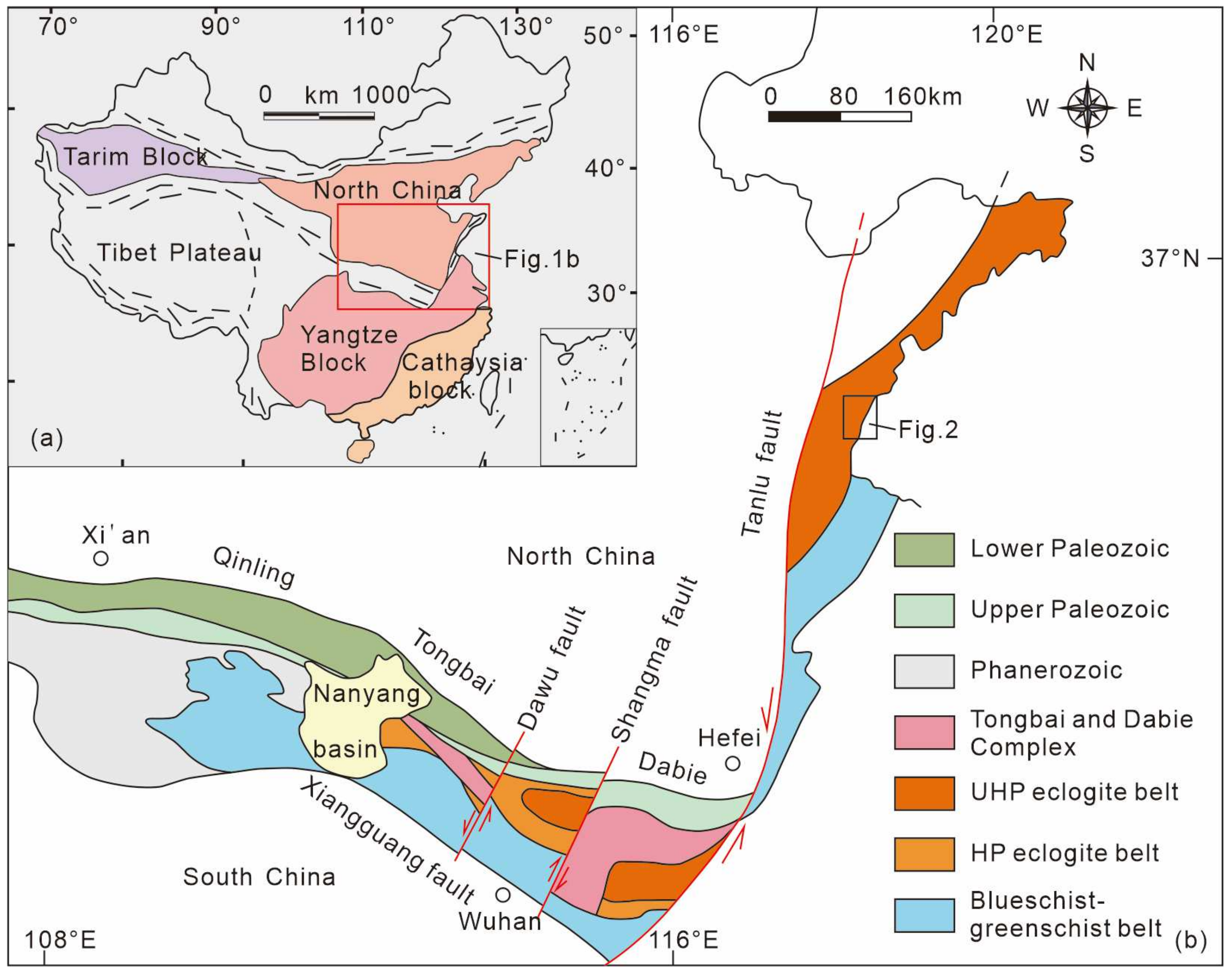


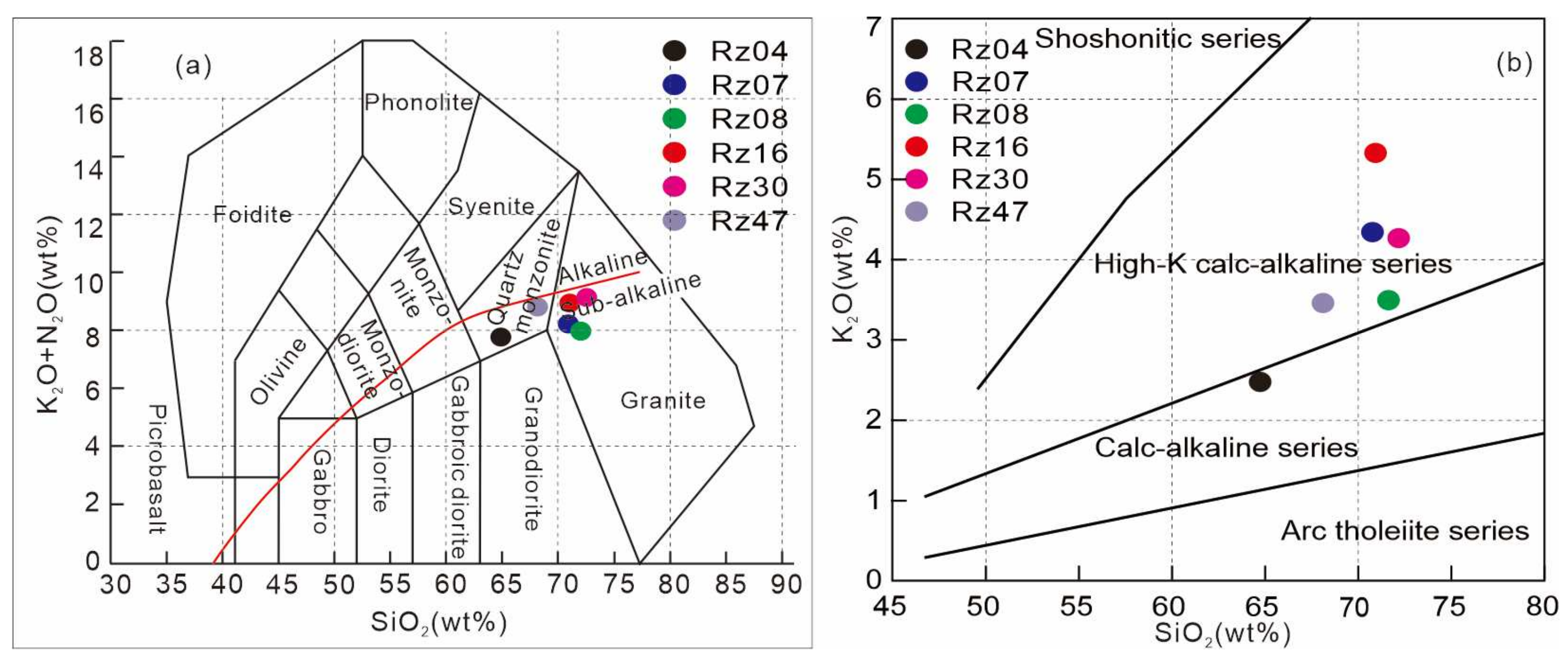

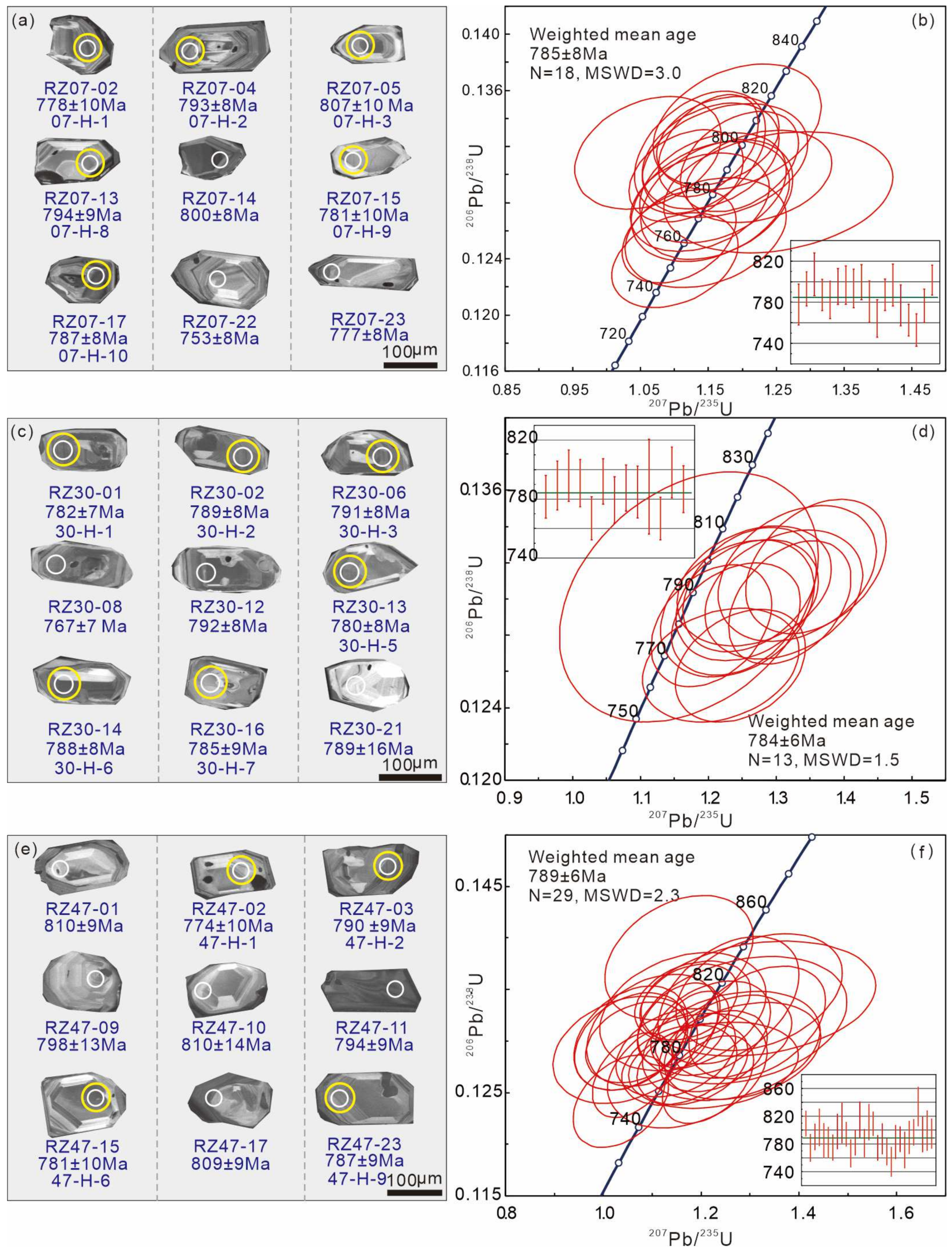
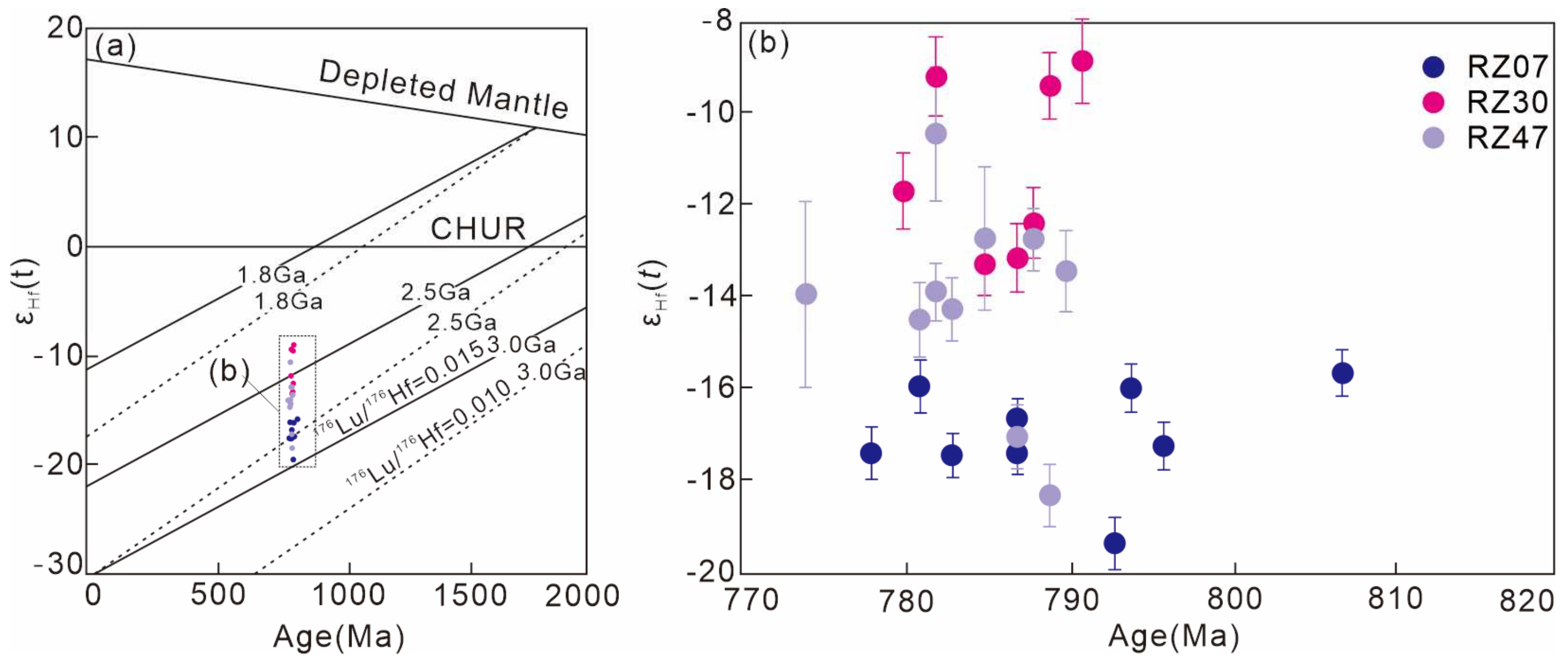
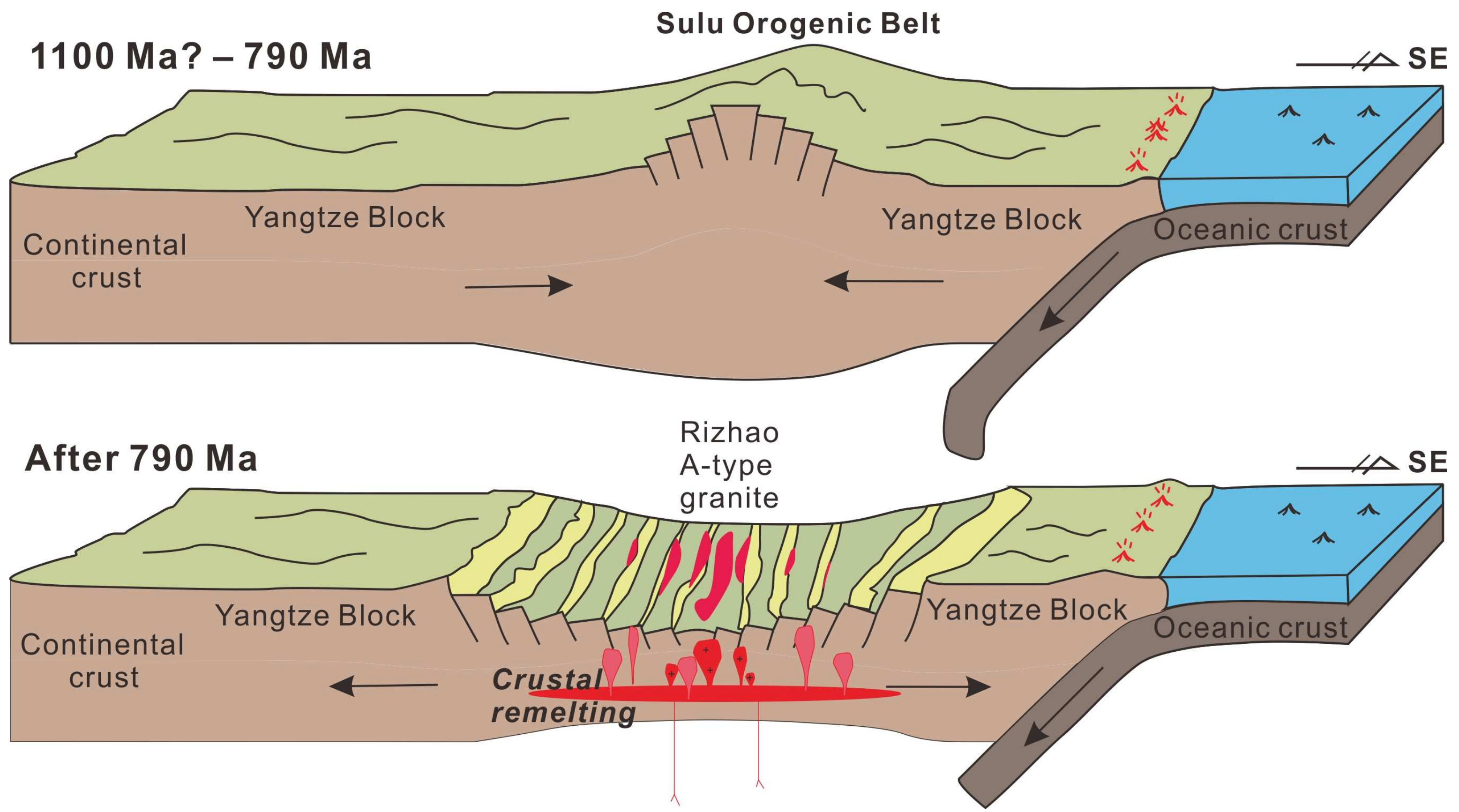
Disclaimer/Publisher’s Note: The statements, opinions and data contained in all publications are solely those of the individual author(s) and contributor(s) and not of MDPI and/or the editor(s). MDPI and/or the editor(s) disclaim responsibility for any injury to people or property resulting from any ideas, methods, instructions or products referred to in the content. |
© 2024 by the authors. Licensee MDPI, Basel, Switzerland. This article is an open access article distributed under the terms and conditions of the Creative Commons Attribution (CC BY) license (https://creativecommons.org/licenses/by/4.0/).
Share and Cite
He, X.; Yang, Z.; Liu, K.; Zhu, W.; Zhan, H.; Yang, P.; Wei, T.; Wang, S.; Zhang, Y. Involvement of the Northeastern Margin of South China Block in Rodinia Supercontinent Evolution: A Case Study of Neoproterozoic Granitic Gneiss in Rizhao Area, Shandong Province. Minerals 2024, 14, 807. https://doi.org/10.3390/min14080807
He X, Yang Z, Liu K, Zhu W, Zhan H, Yang P, Wei T, Wang S, Zhang Y. Involvement of the Northeastern Margin of South China Block in Rodinia Supercontinent Evolution: A Case Study of Neoproterozoic Granitic Gneiss in Rizhao Area, Shandong Province. Minerals. 2024; 14(8):807. https://doi.org/10.3390/min14080807
Chicago/Turabian StyleHe, Xiaolong, Zeyu Yang, Kai Liu, Wei Zhu, Honglei Zhan, Peng Yang, Tongzheng Wei, Shuxun Wang, and Yaoyao Zhang. 2024. "Involvement of the Northeastern Margin of South China Block in Rodinia Supercontinent Evolution: A Case Study of Neoproterozoic Granitic Gneiss in Rizhao Area, Shandong Province" Minerals 14, no. 8: 807. https://doi.org/10.3390/min14080807






